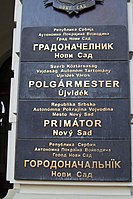
Photo from wikipedia
ABSTRACT This article examines translanguaging that occurs in and as a community. Expanding the notion of translanguaging, we conceptualize community translanguaging as collaborative meaning-making among children, their family and community… Click to show full abstract
ABSTRACT This article examines translanguaging that occurs in and as a community. Expanding the notion of translanguaging, we conceptualize community translanguaging as collaborative meaning-making among children, their family and community members, and their collective semiotic resources. Using a family literacy project as the research site, this article showcases how participating families built (on) cultural and semiotic wealth beyond the individual’s and across diverse sign systems; this was demonstrated both in the process and as the product of family storybooks. Taking an ecological approach and drawing from the notions of spatial repertoires, assemblages, and distributed/collaborative agency, the analysis shows that languaging is inherently social, intertextual, multimodal, and contingent on the dynamic of the semiotic ecology. Families collaborated, cross-culturally, metalinguistically, multimodally, and across generations, to discuss, write, draw, and digitize their family stories. This expanded concept of community translanguaging counters the coded notion of language and resulting separatist paradigm of language education with pedagogical implications. Leveraging community repertoires provides new opportunities to create educational space(s) where more/various semiotic resources can be drawn upon to maximize creativity in teaching and learning. It also can engage families and communities from diverse backgrounds in ways that empower, rather than marginalize, diverse ways with words and beyond.
Journal Title: International Multilingual Research Journal
Year Published: 2021
Link to full text (if available)
Share on Social Media: Sign Up to like & get
recommendations!